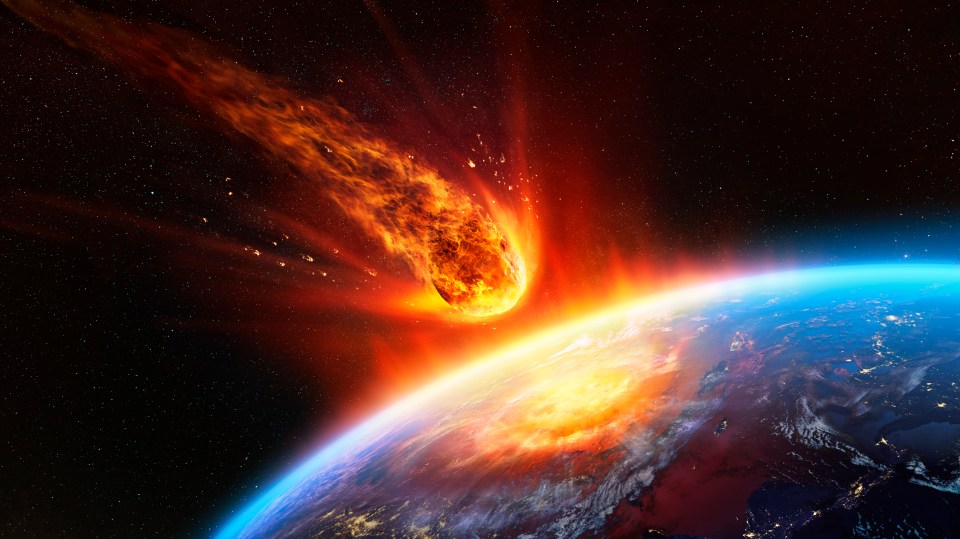IF you’ve got any plans for December 22, 2032, you might want to bring them forward.
Because the chance of an asteroid the size of a football pitch hitting Earth on that date has just doubled.
GettyAn asteroid could rip through the atmosphere at 38,000mph and wreak more devastation than 100 nuclear bombs[/caption]
GettyThe James Webb Space Telescope has been tasked for the first time with observing a Near Earth Object to calculate the risk[/caption]
If the giant rock is on a collision course with our planet, it could rip through the atmosphere at 38,000mph and wreak more devastation than 100 nuclear bombs.
At the moment humankind does not have a foolproof plan to prevent such a catastrophe, despite Nasa’s sci-fi-sounding Planetary Defence Team, set up to detect hazardous asteroids and comets that come within 30 million miles of Earth.
And scientists are worried that we won’t be ready to put current options into action in seven years’ time.
The potential defence systems sound like something out of the Hollywood movies Armageddon or Deep Impact.
They include deflecting the asteroid — named 2024 YR4 — away from a dangerous trajectory or blowing it up with a nuclear device.
Astronomer Dr David Whitehouse warned: “We cannot ignore this rock. It has the potential, the possibility, for being an emergency for planet Earth.
“We might even have to consider the severe measures of sending up a nuclear weapon to the surface of this asteroid in order to deflect it further.”
Asteroid 2024 YR4 was first spotted on December 27 thanks to the Asteroid Terrestrial-impact Last Alert System (Atlas) in Chile.
Travelling through space 515,000 miles from Earth, its chances of hitting our planet were initially calculated at one in 83. But now those odds have shortened to a one in 43 shot (2.3 per cent).
That’s only slightly less chance than Premier League side Ipswich Town have of winning the FA Cup this year.
The UK National Space Operations Centre monitors up to 300 Near-Earth Objects (Neos) every month.
But most of them are too small to pose a threat or too unlikely to reach our atmosphere.
What has concerned scientists about Asteroid 2024 YR4 is its estimated size — between 130 and 300ft wide — and the uncertainty about its position.
That’s big enough to destroy most of a large city.
Dr Robin George Andrews, the British author of How To Kill An Asteroid, is worried we do not have enough time to stop it.
Of the possibility of a mission to deflect it, he tells The Sun: “They can do this. But you want as many years as possible. It’s a bit tight.”
American space agency Nasa started formulating a test mission for deflecting an asteroid in 2015.
BBCAstronomer Dr David Whitehouse warned: ‘We cannot ignore this rock’[/caption]
Professor Brian Cox said preparing a deflection mission would be a ‘good investment’Rex
XDr Andrews thinks a lot more work needs to be done[/caption]
A Double Asteroid Redirection Test (Dart), in September 2022, was successful, nudging the 581ft diameter Dimorphos — which was no threat to Earth — into a new orbit around parent asteroid Didymos.
But the spacecraft took nearly a year to reach its target and the mission took seven years in total from conception to impact.
We only have that amount of time to prevent 2024 YR4 hitting Earth, and Dr Andrews thinks a lot more work needs to be done.
He explains: “It did change the Dimorphos orbit, but it’s still a small change. It’s not like you’re playing pool and you’re knocking it.
“You need a huge spacecraft to do that kind of thing.
“The reason you need a fair number of years to do this in real life is because if you deflect an asteroid, you want to be sure you are deflecting it completely away from the Earth by the time it actually comes around.
“If you deflect it, but not emphatically enough, you might deflect it into another part of the Earth. So you have to be really careful.”
Currently the UK is not in 2024 YR4’s path.
Currently, we don’t have the technology for such a mission.
Dr Andrews
The “impact corridor” includes the eastern Pacific Ocean, northern South America, the Atlantic Ocean, Africa, the Arabian Sea and South Asia.
Astronomers will only be able to observe the potentially deadly celestial object until May at the latest, then they won’t see it again until 2028.
For that reason, the James Webb Space Telescope has been tasked for the first time with observing a Near Earth Object to calculate the risk.
The largest telescope in space, it has been orbiting the sun, a million miles away from Earth, since January 2022 and can view asteroids in infrared vision, allowing their size to be better understood.
If we don’t know the danger posed by 2024 YR4 before it goes out of view, scientists believe we will have to prepare for the worst.
Professor Brian Cox wrote on X/Twitter: “Interesting situation — if the probability remains this high then we will have to make a decision on preparing a deflection mission — which would be a good investment even if (as is most likely) we don’t need to use it this time.”
Nuking it
China is also taking these rogue asteroids seriously, by developing a plan to hit one with a spacecraft.
But Dr Andrews feels the European Space Agency needs to put more funds into this field.
He argues that defending planet Earth is not as expensive as you might imagine.
He says: “Planetary defence is remarkably cheap. The Dart mission costs about $325million, which again, sounds like a lot, but that’s the price of a high-end luxury yacht.”
If humankind can’t unite in time to deflect the asteroid, the other answer would be nuking it.
Dr Andrews says: “Another option is vaporising it.”
Currently, though, we don’t have the technology for such a mission.
Thankfully, if all else fails there should be enough time to evacuate any city that could be hit.
Right now I am not losing sleep over Asteroid 2024 YR4.
Dr Robert Massey
And the other good news is that the odds are changing all the time.
But there are plenty of other asteroids flying through space that we have not yet observed.
There are so-called “planet killers” in the universe.
If one was rated ten on the Torino scale of risk, it “may threaten the future of civilisation as we know it”.
Such events only take place on Earth once every 100,000 years on average.
For that reason Nasa hopes to launch a Neo surveyor in two years’ time to look for hazardous objects.
Dr Robert Massey, deputy executive director of the Royal Astronomical Society, concluded: “Right now I am not losing sleep over Asteroid 2024 YR4.
“But one day, one of these asteroids will be on course to hit Earth and we need to be prepared for that.”
Unlock even more award-winning articles as The Sun launches brand new membership programme – Sun Club.

